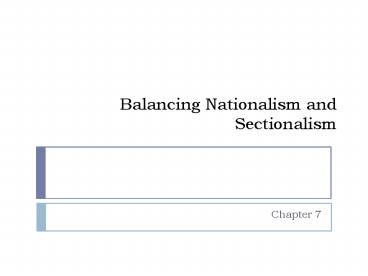Balancing Nationalism and Sectionalism PowerPoint PPT Presentation
1 / 13
Title: Balancing Nationalism and Sectionalism
1
Balancing Nationalism and Sectionalism
- Chapter 7
2
Section 1 Regional Economies create Differences
- Industrial Revolution
- Factories became the new centers of industry
- Mass production
- Two events caused America to turn attention to
the development of domestic industries - 1. Embargo Act of 1807
- 2. War of 1812
- Americans had to invest capital outside of
shipping
3
New England Industrializes
- 1793-Samuel Slater establishes mechanized textile
factory in Rhode Island - Factory only mass-produced one part of the
textile thread. - 1813- Francis Cabot Lowell, Nathan Appleton, and
Patrick Tracy Jackson built a weaving factory in
Massachusetts - mechanizing all the stages in the manufacture of
cloth. - Outfitted it with power machinery.
- Town of Lowell became a booming manufacturing
center- thoughts of young women came to find work
after declining family farms (pg.262)
4
Agriculture
- North
- Type of land a growth of cities encouraged
farmers to make smaller farms - Raise one or two types of crops or livestock and
sell it at city markets - Little need for slavery
- South
- 1793- Eli Whitney invents the cotton engine.
- The gin made it possible for cleaning the seeds
from short-staple cotton. Allowed farmers to
grow the cotton for a profit with increasing
demand in the North and Britain. - Cotton production growth increases the number of
slaves in the south.
5
The American System1815
- President Madison presented a plan to Congress to
unify the nation due to the development of
different economies (N/S) - Three points
- Develop transportation system
- Establish protective tariff
- National Bank
- House Speaker Henry Clay promoted the system
6
Internal Improvements
- Had to communicate, travel and transport goods
with one another - Steam Locomotive built in 1825
- Railroads-offered advantages to other modes of
transport (fast, cross terrain, operate in severe
weather) - National Road- Maryland to Illinois
- States built turnpikes
- Erie Canal- connect Atlantic Ocean to Great Lakes
- 363 miles 8 years to build canal tolls paid for
construction in 12 years
7
Ch 7 Section 2Nationalism at Center Stage
- Supreme Court strengthens federal government
- Gibbons vs. Ogden
- McCulloch v. Maryland
- Fletcher v. Peck
- Foreign Policy
- Rush-Bagot Treaty US and Canada common border
joint occupation of Oregon Terrority for 10 yrs
with GB - Adams-Onis Treaty- Spain ceded Florida to US
- Monroe Doctrine- warned outside powers not to
interfere with Western Hemisphere and US would
not get involved with other countries.
8
Expansion to the West
- Settlers move into the Northwest Territory some
went to escape debts or the law, most went in
search of economic and social gain. - THE MISSOURI COMPROMISE
- 1819, settlers requested admission as a state.
Issue of Slavery arose- 11 free and 11 slave
states balanced the Union. - The Louisiana Territory was split into two
spheres of interest, one for slaveholders and one
for free settlers. Dividing Line was set at 36
30 north latitude. - South-slave states
- North-free states (except Missouri)
9
(No Transcript)
10
Chapter 7 Section 3The Age of Jackson
- Elected President in 1828
- Heated campaign with John Quincy Adams
- Removal of Native Americans
- White settlers had two attitudes
- Displacement or convert
- Five Civilized Tribes began to adopt European
culture after War of 1812 - Jackson thought assimilation could not work.
- Passed the Indian Removal Act of 1830. Federal
government provided funds to negotiate treaties
that would force the Native Americans to move
west. - 90 treaties were signed
11
Cherokee Fight Back
- The Cherokee Nation tried to win just treatment
through the US legal system. Justice Marshall
refused to rule on the case saying the Cherokee
had no federal standing. - In 1835, a treaty was signed for 5 million and
begins the exodus. - In 1838, Pres. Van Buren orders them to be
forceably removed - Trail of Tears
- 1838 Cherokee tribe were sent off in groups of
1000 on an 800 mile trip - Party by steamboat and railroad but mostly on
foot - More than 25 died on the trip
12
Reforming American Society Ch8
- Rural Manufacturing
- cottage industry system- manufactures provided
the materials for goods to be produced at home - Paid by the piece and given new materials for the
next batch of work - Power looms replace cottage industry by the 1830s
- Early Factories
- Master
- Journeyman
- Apprentice
- Lowell Mill Girls
- Immigrant growth
- Unions organize for better conditions
13
Compare Lives

